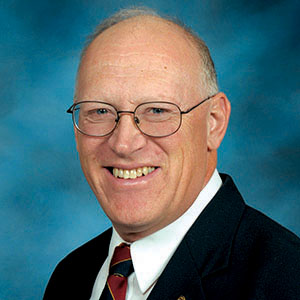Kansas Profile – Now That’s Rural: Bob Morin, Damar
At a glance: After successful careers, Bob Morin and Kaylon Roberts decided to invest in their hometown. Both are active in the Damar Community Historical Foundation. Downtown buildings have been renovated and trash is picked up immediately, making Damar one of the cleanest communities in the country.
More information: Ron Wilson, rwilson@ksu.edu, 785-532-7690
Photos: Ron Wilson | Damar (Kan.) Main Street
Website: Huck Boyd National Institute for Rural Development
May 8, 2024

By Ron Wilson, director of the Huck Boyd National Institute for Rural Development at Kansas State University
Where is the cleanest little town in the U.S.?
![]() According to at least one source, it is Damar, Kansas. Not only have people in this community worked hard to improve the appearance and infrastructure of their town, they are preserving their history and investing in its future.
According to at least one source, it is Damar, Kansas. Not only have people in this community worked hard to improve the appearance and infrastructure of their town, they are preserving their history and investing in its future.
At right: Main Street, Damar (Kan.) | Download this photo
Bob Morin is the source for much of this information about Damar in northwest Kansas. He also referred us to Kaylon Roberts, president of the Damar Community Historical Foundation. Both men were born and raised in Damar.
Morin lived on a farm homesteaded by his grandfather near Damar. He graduated from K-State and had a career in agribusiness before retiring to Manhattan where he lives today.
Roberts studied business administration at Creighton University and was an accountant in Colorado.
Neither man forgot his hometown. After tiring of urban life in the Denver area, Roberts renovated six downtown buildings in Damar before moving back to the community full-time.
In 2014, several families got together to form the Damar Community Historical Foundation. Roberts is president. Retired banker Jim Desbien is treasurer. “Bob (Morin) has been a major donor,” Roberts said.
“(The foundation) has three main objectives,” Roberts said. “One is to support the community and all its institutions; the second is to preserve and document our history; and the third is to establish a visitors center,” he said. “We’ve had quite a bit of success.”
Most families in the community are of Catholic French Canadian descent. The French influence is so strong that Damar is called the “Acadia of the West,” referencing the first French colony known as Acadia in eastern North America. The Damar foundation visitors center, a building donated by the Roberts family, is called the French Quarter.
“We’ve been able to gather lots of genealogy information and books that people have written about their families,” Roberts said.
St. Joseph’s Catholic Church is a magnificent Romanesque structure built in 1913, with renovations and additions since. “The church is the center of what’s holding the community together,” Morin said.
“People in Damar are proud people,” Morin said. “It’s a very clean community. If there’s a piece of junk unclaimed for 24 hours, it’s hauled away.”
“Our mayor, Brian Newell, is really good about those things,” Roberts said. “He’s the lawn and cleanup guy, I’m the painting guy.”
The Damar Community Historical Foundation is affiliated with the Hays and the Greater Salina community foundations. “We’re raising funds to help sustain our efforts,” Roberts said.
The foundation launched a project called Double Down for Damar. People were invited to purchase one of the colorful metal benches that are being placed around town. The purchaser’s family name and pictures in acrylic are then placed on the bench.
Morin bought one in honor of his grandparents, Stanislaus and Rosanna Morin. “Stanislaus first lived in a dugout and then a soddy before they got their first wood frame home,” Morin said.
“Nineteen benches have been sold,” Roberts said.
All told, six downtown buildings have been renovated in addition to the houses that have been repaired and repainted.
“It’s just a great community, a modern town with all the modern conveniences,” Morin said. “Everybody looks out for everybody else. There’s low taxes, low crime rate, and friendly people.”
Roberts appreciates the contrast with urban life. “The city got to be too much traffic,” he said. “It takes me as long to drive to the medical clinic in Plainville as it took me to drive to my doctor when we were living in Denver.”
Today, Damar is a community of 112 people. Now, that’s rural.
More information can be found at www.damarkansas.com. For foundation information, see www.damarcommunityhistoricalfoundation.org.
Where is the cleanest little town in the U.S.? It just might be Damar, Kansas, where houses have been repaired and repainted and downtown buildings have been renovated while citizen pride keeps the community clean.
We commend Bob Morin, Kaylon Roberts, and all those who are making a difference by supporting Damar. Their continued success is like a clean sweep.
Audio and text files of Kansas Profiles are available at http://www.kansasprofile.com. For more information about the Huck Boyd Institute, interested persons can visit http://www.huckboydinstitute.org.
***

K‑State Research and Extension is a short name for the Kansas State University Agricultural Experiment Station and Cooperative Extension Service, a program designed to generate and distribute useful knowledge for the well‑being of Kansans. Supported by county, state, federal and private funds, the program has county extension offices, experiment fields, area extension offices and regional research centers statewide. Its headquarters is on the K‑State campus in Manhattan. For more information, visit www.ksre.ksu.edu. K-State Research and Extension is an equal opportunity provider and employer.